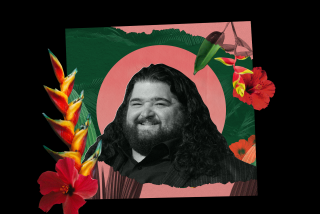On a Mission to Resuscitate a Lost Culture : TURNAWAY by Jesse Browner; Villard $23, 290 pages
- Share via
First, Jesse Browner asks us to suspend our disbelief. Imagine an uncharted island in New York Harbor, he says. A thickly forested 20-acre island called Turnaway, from which the Manhattan skyline is visible but appears as insubstantial as a dream.
Turnaway has two residents: Joseph Ross, an elderly doctor with an Eastern European accent, and his ward, Elias Hutchinson, a 29-year-old boy-man who believes himself to be the sole survivor of a Native American tribe, the Siwanoy, and acts as if the 20th century is, in fact, a malign illusion.
Remember the famous passage at the end of F. Scott Fitzgerald’s “The Great Gatsby”? When the narrator, Nick Carraway, gazes at a New York suburb by night and sees “the inessential houses begin to melt away until gradually I became aware of the old island here that flowered once for Dutch sailors’ eyes--a fresh, green breast of the new world.”
Hutchinson thinks this way all the time. Descended, he asserts, from Wampage, a Siwanoy chief who fought the Dutch, killed the English mystic Anne Hutchinson in 1643 and had children by her captive daughter, he steeps himself in ancient lore with the goal of resuscitating the tribe.
To do this, he must marry an ideal Native American princess he calls the “Mahkokwe,” whom he has glimpsed once visiting Turnaway. Actually, the woman he saw is a lawyer representing the city’s efforts to condemn the island and turn it into a new potter’s field--a graveyard for the indigent dead--but Ross has shielded him from such realities. All Hutchinson knows is that he must go into the big, bad city to find her.
Opportunity arrives in the person of Browner’s narrator, Ben Givens, a modern New Yorker disabled by a subway accident and embittered by his past as an orphan and foster child. When Givens is washed up on the island after his small boat founders in a storm, Hutchinson, also an orphan, embraces him as a kindred spirit.
The cold, secretive Ross warns Givens that Hutchinson is living out a fantasy. Givens tries to discourage his new friend from pursuing his “princess” but, like Carraway, he’s a lot less cynical than he wants us to think.
Like Gatsby, Hutchinson at first succeeds remarkably in his romantic quest, though disaster seems inevitable.
We shouldn’t take the Fitzgerald comparison too far--Gatsby is tainted, Hutchinson, pure; Gatsby seeks “the green light, the orgiastic future,” whereas Hutchinson wants to bring back the unspoiled past--but both are quintessential Americans, self-invented men, trying to lasso our mightiest city with nothing more than the gossamer rope of an idea.
Browner (“Conglomeros”) has researched the historical aspects of this second novel exhaustively. His publisher says he learned the rudiments of Munsee, a once-widespread Algonquian language that now has fewer than a half-dozen native speakers. With equal felicity, he describes Wampage’s exploits, modern New York’s labyrinthine waterways, Hutchinson’s courtship of the lawyer, Emily Wolfe, and the gnarled terrain of Givens’ soul.
“Turnaway” is a stylish and original creation: a valedictory for lost cultures, a social comedy and an inquiry into the nature of friendship.
The only trouble is with the ending. It’s a catastrophe, as we expected, but a curiously subdued catastrophe, leaving a number of issues and relationships hanging. It’s a realistic ending, in its way, and that’s the last thing we want after Browner’s suspension-of-disbelief strategy has worked so nicely for so long, proving to us as well to Givens that “everything, even a great big city . . . has an outer skin that can be peeled or burned away” by the sympathetic imagination.
More to Read
Sign up for our Book Club newsletter
Get the latest news, events and more from the Los Angeles Times Book Club, and help us get L.A. reading and talking.
You may occasionally receive promotional content from the Los Angeles Times.








